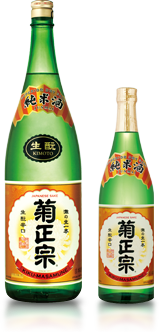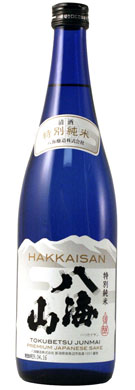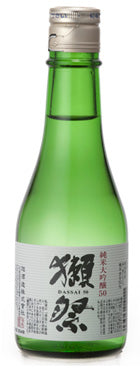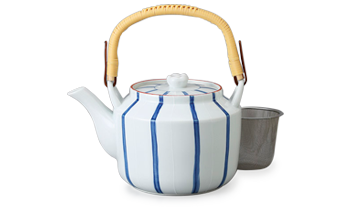Sake Tasting Note
Types of Japanese Tea Set
Japanese Teacup Selection
After you have chosen a suitable teapot and a green tea flavor, you can start looking for a teacup to enhance the drink’s aroma and flavor.
When serving specific varieties of tea, it isn’t necessary to use teacups of a certain shape. This is a key difference between teacups and teapots. Still, because every variety seeps a different way (for the sake of improving a tea’s special qualities), it’s worthwhile to learn more about all the Japanese teacup variations out there.
The Material of Japanese Teacups
For the most part, there are a trio of teacups to choose from: glass, clay, and porcelain.
Glass Teacups
For iced green tea in the summertime, glass teacups should be used.
Clay Teacups
Clay teacups are used frequently in Japan. They mostly come fire-glazed and feature a more conventional Japanese look. “Wabi-Sabi” is a Japanese phrase used to articulate the style.
Porcelain Teacups
Japanese teacups made of porcelain are often seen in Japanese households. They are lightweight, thin, and are found in all sorts of sizes and shapes.
Shapes of Japanese Teacups
There are a slew of subtle shapes to choose from when it comes to Japanese teacups. Many shapes tend to fall within one of these 3 categories:
Tapered Side Teacups

Teacups that have this shape are capable of improving the aroma of green tea. They're also an ideal choice for sencha and gyokuro, among other varieties.
Take the Color of the Teacup into Consideration
Teacup color really comes down to your tastes. However, when it comes to green tea, a teacup’s exterior color can impact the tone of the beverage once it’s poured out. With that in mind, it’s worthwhile to have an extra set of teacups on hand – preferably white ones – if you want to display your green tea’s vibrancy.
Japanese Matcha Bowl

There is nothing quite like holding a chawan (Matcha bowl) and bringing it towards your mouth to sip some Matcha tea. A large bowl only contains a small amount of tea, as per Japanese tradition. Consumption of green tea (powdered) started during the 15th century in Japan. That’s when the demand for meticulously-crafted tea bowls began, too.
How to Pick the right Japanese Tea Set
With all the teacups and teapots you can pick from these days, you may have difficulty picking a Japanese tea set that suits your tastes and preferences. Since green tea has been consumed in Japan for centuries, the sizes and shapes of teacup and teapot selections have changed throughout time. Also, specific varieties of green tea have their own characteristics, which influences your choices. Keep reading to learn more about Japanese tea set distinctions and designs.
Selecting the right Japanese Teapot
Stylistic preferences aside, we encourage you to consider the following criteria when browsing for Japanese teapots, as well as their filter types, sizes, shapes, and materials.
Porcelain Teapots vs. Clay Teapots
For the most part, the materials Japanese teapots are created either with stoneware (clay) or porcelain. When it comes to clay teapots, you’ll have greater interaction between the pot and the tea. Clay varieties – such as Banko-yaki and Tokoname-yaki – are renowned for creating tea with a mellower taste, as the umami element is enhanced. This can be attributed to the iron content in clay, which is high. A subsequent chemical reaction is produced by the tannins inside the leaves of the tea.
On the other hand, porcelain teapots are quite flexible - they can brew all kinds of teas because the aroma of the drink is absorbed by the pot.
4 Fundamental Shapes of Japanese Teapots
When it comes to Japanese teapots, there are a quartet of fundamental shapes. The key distinction between them all comes down to the design of the handle. If you’re wondering what the difference is between a “kyusu” and the Japanese teapot, the answer is: they’re both the same thing.
Side-Handle Teapot (Yokode Kyusu)

On a yokode kyushu, the handle will usually be found on the right portion. This allows you to place your thumb on the lid top, stopping it from coming off during your pour.
Sizes of Japanese Teapots
When browsing for teapots, it is vital to keep in mind which size is ideal for the tea you plan to serve. For instance, if you enjoy gyokuro and tend to drink it alone, you’ll be fine using a hohin. It may be worthwhile to get a big dobin if you enjoy drinking hojicha with your family after a meal.
It is feasible to have sencha prepared with a big dobin. Be mindful, though, that it can be troublesome to control the water temperature with this teapot. Inconsistent seeping may ensue.
Is a Yuzamashi Required?
A cooling cup without a lid is called a yuzamashi. The handle is either on the side or back, and occasionally, it features a pour spout. A yazamashi can be used to bring down the temperature of boiled water. Though it isn’t essential to use, a yazamashi can be a great addition to a green tea collection.
Japanese Tea Set
A tea ball is a great way to brew green tea, and tea made with it will always taste good. However, in many cases it is simply too small for the tea leaves to infuse properly. This means that you will not achieve the full flavor from the loose leaf. Instead, we would suggest that you use a teapot that has a removal metal basket, and you can place the loose leaf tea here. A teapot called Kyusu has a metal strainer that lies over the inside of the spout, which means that you can put the loose leaf green tea directly into the teapot.
Arita Porcelain Tea Set

Imari (Arita) porcelain is the name for Japanese porcelain wares made in the town of Arita. The craftsmanship, production, drawing techniques, and unique designs with 400 years of history, continues to make Arita porcelain number one in Japan.
Hagi Ware Tea Set

The charm of Hagi Ware lies in the rough texture of the clay and the pockmarked surfaces laced with cracks in the glaze. Hagi Ware is liquid-permeable. This results in another interesting characteristic, that is, that its color and tone change with use, especially if used to drink tea.
Kutani Ware Tea Set

Kutani ware which is multicolored over glazed porcelain is incredibly precious and highly appreciated due to its unique, formal and vigorous beauty.
Okunomatsu Junmai Dai Ginjo

A luster-laden aroma and a pleasantly dry flavor. Makes an excellent gift for those important people in our lives.
Okunomatsu Dai Ginjo Shizukusake "Juhachidai Ihei"

Special sake that is allowed to drip naturally from cotton bags with no pressure applied. An exquisite finegrained daiginjo flavor with a mellow essence and aroma.
Kurosawa Junmai Kimoto

This sake boasts a natural Kimoto flavor, which is full-bodied and earthy, yet light. It is exquisitely balanced and masterfully brewed as the almighty sake. Kimoto-produced Junmai sakes, served hot, cold or at room temperature, will exhibit their true, rich qualities. Ideal for sake lovers.
Kurosawa Junmai Dai Ginjo

The ingredients and the method of fermentation and are unique. Toji gathers only the finest rice grains and then refines them to forty percent of the original grain size which is the bare essence of the rice core.
Hakkaisan Honjozo

Hakkaisan Honjozo is a popular and versatile sake that is easy to drink and easy to enjoy. Serve it gently warmed to bring out the mild flavors of koji and rice. Hakkaisan Honjozo when chilled will give you a clean and straightforward, yet enjoyable sake that pairs easily with many foods. Their Honjozo is one of the bestselling and most accessible sakes.
Hakkaisan Ginjo

Hakkaisan Ginjo is a sake born of the frigid, snowy winters in Niigata, Japan. Ginjo-shu is, in essence, a fortified style of sake and they take that technique to the next level of quality and craftsmanship. The special production methods and attention to detail coax out a richer body and more intricate aroma. Whatever the season, you’ll be charmed by the expressive nature of our Hakkaisan Ginjo.
Hakkaisan Junmai Ginjo

The signature Hakkaisan Junmai Ginjo calls to mind the crisp air and gentle snow of a fine winter’s day. You’ll enjoy the hints of rice and the mellow texture of this delicious brew. Look for exceptional clarity of flavor and a quiet elegance on the palate. This crisp, clean sake is a landmark example of the Niigata sake brewing style. A lightly dry finish cleans your palate and makes our Junmai Ginjo a very food friendly sake, indeed.
Hakkaisan Dai Ginjo

Hakkaisan Daiginjo is the pinnacle of the sake brewer’s art. Crisp and beautiful, our Daiginjo is crafted only during the coldest winter months to ensure the highest quality. Milled to a luxurious 40% of each rice grain remaining, our Daiginjo uses pure Yamadanishiki sake rice. One sip of this super premium sake evokes the pristine snow surrounding our brewery and reveals the essence of Hakkaisan’s clean and exceedingly smooth character.
Kiku Masamune Honjozo Sake

The authentically dry Honjozo Sake boasts a refreshing, rich taste that is free of impurities and a clean, crisp finish. Since Kiku Masamune switched to the traditional Kimoto method for brewing it in September 2009, they have refined this exceptional label to perfect a balanced taste and powerful, crisp finish. Kiku Masamune invites you to make this sake your choice at the dining table.
Kiku Masamune Junmai Sake

Unlike most breweries' current practice of adding commercially purchased lactic acid, the Kimoto method is a traditional and painstaking technique for cultivating robust yeast slowly and methodically by tapping the natural biological power of living lactic acid bacteria. Strong yeast cultivated using the Kimoto method continues to actively ferment even as the alcohol content of the sake mash increases toward the end of the fermentation period, creating a refreshingly dry sake with very few impurities.Kiku-Masamune invites you to enjoy the refined taste of this dry Junmai Sake, which is made possible by the Kimoto method.
Kiku Masamune Junmai Ginjo

A sake made with a rice polishing ratio of 60% or less and only rice and malted rice (kome-koji) as ingredients (by contrast, junmai dai-ginjo is made with a rice polishing ratio of 50% or less), resulting in a mellow, balanced, and refreshing savoriness along with a full-bodied, fruity aroma.
Kiku Masamune Junmai Dai Ginjo

Their superbly balanced Junmai Dai-Ginjo is distinguished by slight, soft sweetness and elegant fragrance; a smooth finish; and an understated, mellow aftertaste.
Kikusui Junmai Ginjo Tasting Note

This sake carries great rich flavor of Junmai, as well as clean, refreshing aftertaste of Ginjo. Banana like fruity aroma and clean after taste are loved and enjoyed by everybody.
Shirakabe Gura Tokubetsu Junmai

Using premium sake rice, GOHYAKUMANGOKU, and polish it down to 60% of its original size, this Tokubetsu Junmai sake was fermented slowly and carefully in lovw temperature. The taste is thick and mellow with great aroma and flavor of Rice.
Hakkaisan Tokubetsu Junmai Tasting Note

In Japanese tokubetsu means “special” and Hakkaisan Tokubestu Junmai is special in many ways. The signature ingredient of this sake is the fine local water, coming from melting snow and filtered by Mount Hakkai.
Dassai 50 Junmai Daiginjo Tasting Note

Dassai 50 is a premium junmai daiginjo sake, made from only rice milled down to 50%, water and koji mold. Clean, soft and very subtle, the balanced aromas and a mild sweetness envelop the senses making Dassai enjoyable on its own, or with a meal of refined cuisine.





